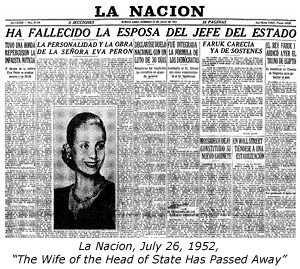| Historians generally use newspapers
for three purposes: learning facts about specific events; looking
for long-term trends; and searching for details or the “texture”
surrounding an event—a fact or story that illuminates or complicates
a larger pattern. Newspapers are often the first kind of source historians
of the past two centuries will turn to for gathering evidence, but
historians rarely rely on newspaper evidence alone.
Learning Facts
Newspapers can be used to locate facts related
to a specific event. Historians investigating a specific event sometimes
use newspapers from the place and time in which the event occurred
to uncover details and perhaps find firsthand descriptions. But when
historians use newspapers in this way, they proceed with caution,
as newspapers often include factual errors and always reflect a point
of view. Newspaper reports are frequently incomplete, biased, and/or
inaccurate.
 For
example, Argentinean newspapers covering the death of Eva Peron in
1952 explained it in many ways, none of them truthful, because the
Peronist government and newspaper editors agreed that the phrase “ovarian
cancer” was too sexual to be printed. For
example, Argentinean newspapers covering the death of Eva Peron in
1952 explained it in many ways, none of them truthful, because the
Peronist government and newspaper editors agreed that the phrase “ovarian
cancer” was too sexual to be printed.
Furthermore, newspaper coverage assumes that readers
share knowledge about the circumstances of the event that historians
decades later may or may not know. In the case of Eva Peron’s
death, for example, reporters and editors at the time did not have
to explain who Evita was, give the location of the cemetery, or provide
details about local funeral practices. Anyone who bought a Buenos
Aires newspaper at the time already knew that.
These problems do not mean that historians should
avoid using details from newspapers. Rather, historians researching
a particular event usually examine newspaper coverage from several
different papers, and look most carefully at coverage by newspapers
closest to where the event took place. They also check the details
they take from newspaper stories against other types of documents.
In the case of Evita’s demise, they might examine maps of Buenos
Aires, the coroner’s report, and her husband’s memoirs.
Looking for Long-Term Trends
Another strategy is mining newspapers for evidence
of long-term trends. Here we often look at more than just the newspaper
stories. Classified advertisements, for example, can tell us about
changes in prices of apartment rentals over time, or about the titles
or salary ranges for various kinds of jobs. Display advertising can
tell us how many new movie theaters are opening in a town or what
kinds of food people are looking for in the supermarkets. Even long-running
advice columns can give us this kind of evidence, showing changes
over time in what people considered to be problems and what newspaper
writers considered to be solutions for those problems.
This strategy can include skimming through a large
group of newspapers looking for something on a particular topic—political
demonstrations, floods, or outbreaks of measles, for instance—over
a period of months, years, or decades. A historian taking this approach
may decide not to read every page of every newspaper in the period
that interests her, but to look at a random selection, like the second
day of every month for 30 years or only the months of August and November
for a decade.
Using newspapers in this way requires some previous
sense of historical context, since historians are reading in hopes
of having “something jump out” at them. They must be able
to quickly and efficiently recognize items that fit or contradict
the pattern that concerns them. One good way for beginners to acquire
such a background is to review a few textbooks dealing with the time
and place they hope to study.
Search tools such as Lexis-Nexus and the headline
index of the New York Times help a great deal with this second
kind of research in newspapers. Unfortunately, indexing for the great
majority of the world’s newspapers started in the 1990s, if
they have any indices at all. Historians hoping to study earlier times
and other parts of the world will still spend many hours looking through
actual newspapers or scanning microfilm copies for some time to come.
Searching for Details
A third strategy is searching for the “texture”
of an event. Details from other parts of the newspaper can help flesh
out a newspaper story. Weather reports can tell us if it was raining
on the day of the battle. Department-store advertising can suggest
what people might have worn to vote on the day of the election. Movie
reviews and television listings can tell us what stories people cared
about in the month of an epidemic.
 
|



